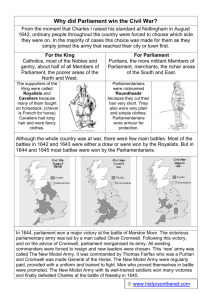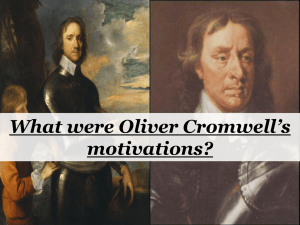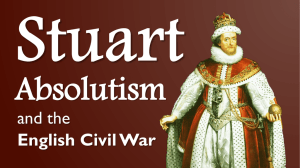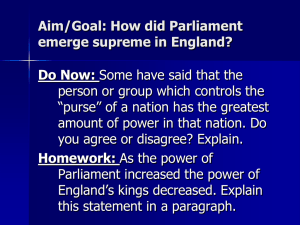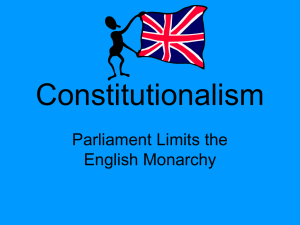The Civil War - EBIS Key Stage 3 History
advertisement
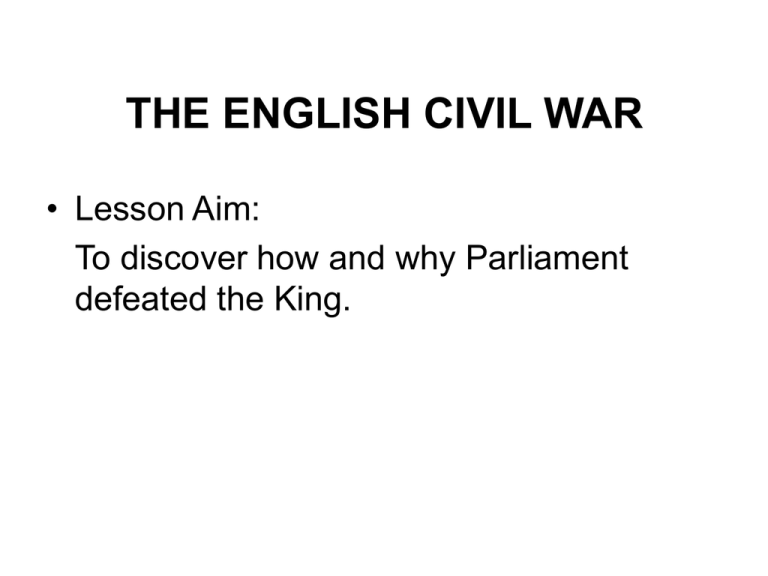
THE ENGLISH CIVIL WAR • Lesson Aim: To discover how and why Parliament defeated the King. The Civil War The Civil War • On 25 August 1642 Charles I raised his standard at Nottingham, signalling the start of the Civil War. The Civil War • On 25 August 1642 Charles I raised his standard at Nottingham, signalling the start of the Civil War. • Ordinary people throughout the country now had to choose which side they were on: their King or their Parliament. The Civil War • Often the choice divided families: two brothers could join different armies, or fathers might fight against their sons. The Civil War • Often the choice divided families: two brothers could join different armies, or fathers might fight against their sons. • However, in many cases, people simply joined the army that reached their city or town first. For the King! • The King had support from the nobles and gentry. For the King! • The King had support from the nobles and gentry. • He also had support in Ireland, Wales, and in the North and West of England. For Parliament! • The Puritans fought on Parliament’s side. • Parliament also had support from the richer areas of the country in South and Eastern England. Why did Parliament win? Why did Parliament win? • Although the whole country was at war, there were not very many important battles. Why did Parliament win? • Although the whole country was at war, there were not very many important battles. • Most of the battles in 1642 and 1643 were either a draw or were won by the Royalists. Why did Parliament win? • Although the whole country was at war, there were not very many important battles. • Most of the battles in 1642 and 1643 were either a draw or were won by the Royalists. • But in 1644 and 1645, most battles were won by the Parliamentarians. Why did Parliament win? • Why did Parliament start doing so well? Cromwell and the New Model Army Cromwell and the New Model Army • After the Battle of Marston Moor in 1644, an MP called Oliver Cromwell reorganised Parliament’s Army. Cromwell and the New Model Army • After the Battle of Marston Moor in 1644, an MP called Oliver Cromwell reorganised Parliament’s Army. • This new army was called the ‘New Model Army’. Cromwell and the New Model Army • After the Battle of Marston Moor in 1644, an MP called Oliver Cromwell reorganised Parliament’s Army. • This new army was called the ‘New Model Army’. • It was commanded by Thomas Fairfax and Oliver Cromwell. Cromwell and the New Model Army • The soldiers in the New Model Army were regularly paid, provided with a uniform, and properly trained to fight. Cromwell and the New Model Army • The soldiers in the New Model Army were regularly paid, provided with a uniform, and properly trained to fight. • This was a totally new idea at the time! Cromwell and the New Model Army • The soldiers in the New Model Army were regularly paid, provided with a uniform, and properly trained to fight. • This was a totally new idea at the time! • The New Model Army with its well-trained soldiers finally defeated Charles at the Battle of Naseby in 1645. BIG QUESTION FOR PARLIAMENT: • What should they do with the King? Your Task • It is 1645 and Parliament has just won the Civil War. Your Task • It is 1645 and Parliament has just won the Civil War. • You are a member of Cromwell’s New Model Army, and are feeling happy and victorious. Your Task • It is 1645 and Parliament has just won the Civil War. • You are a member of Cromwell’s New Model Army, and are feeling happy and victorious. • Write a diary entry explaining the following: Your Task • • • • • Who supported the King, Who supported Parliament, When the war began, Cromwell and The New Model Army, How Parliament won.
